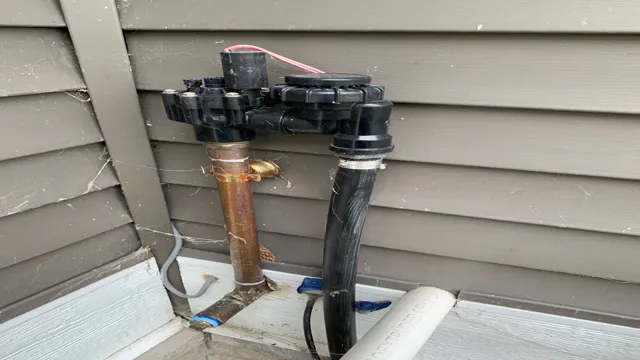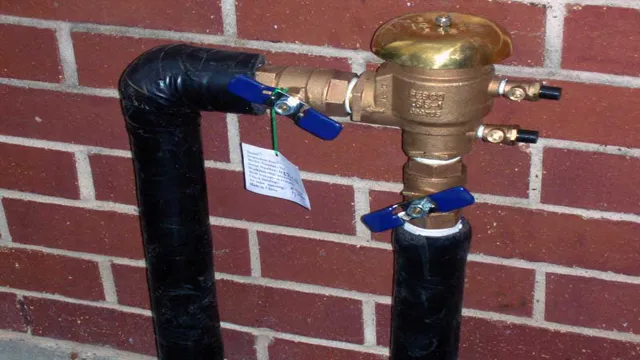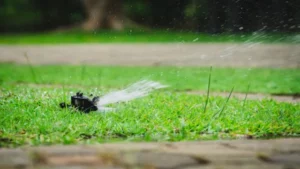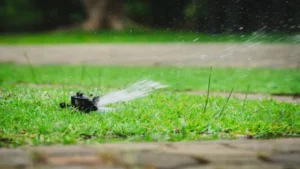As colder temperatures approach, it’s essential to prepare your sprinkler system for the winter months. One of the crucial steps in the process is to drain the water from the system to prevent any damage that can happen due to freezing. However, many homeowners may find the process confusing and may not know where to start.
But don’t worry, draining the sprinkler system is a quick and easy process that doesn’t require professional help. In this blog post, we will go over all the steps you need to take to drain water from your sprinkler system and keep it safe until next spring.
Why is it Important to Drain Your Sprinkler System?
If you are a homeowner who lives in an area with freezing temperatures, then it’s crucial that you learn how to drain water from your sprinkler system. What some people don’t realize is that water left inside the sprinkler system can freeze, leading to burst pipes and costly repairs. To avoid this problem, it’s essential to drain the water from your sprinkler system.
The process might seem overwhelming, but it’s relatively straightforward. First, locate the main shut-off valve for your sprinkler system and turn off the water supply. Next, open the drain valves on your system, allowing the water to drain out.
Once all the water has drained out, close the drain valves and turn the main water supply back on. By taking the time to drain your sprinkler system, you can protect your investment and avoid costly repairs.
Prevents Freezing and Damage
One of the most important maintenance tasks for your sprinkler system is draining it before winter. Freezing temperatures and water inside your system can cause significant damage, leading to costly repairs in the spring. Not only can pipes burst, but water remaining in your sprinkler system can also cause damage to valves, fittings, and other components.
By effectively draining your system, you are preventing unwanted consequences and ensuring your sprinkler system remains functional for years to come. Neglecting this simple task can lead to avoidable headaches, so be sure to add it to your fall maintenance checklist. Your sprinkler system will thank you.

Removes Dirt and Debris
When it comes to maintaining your sprinkler system, draining it regularly is important to remove dirt and debris. Over time, sediment and other debris can build up in the system, which can lead to clogs and inefficiencies. Draining the system helps to flush out these impurities, ensuring that your sprinklers work properly and effectively.
Neglecting to drain your sprinkler system can result in a whole host of problems, like broken pipes and valves, water waste, and poor irrigation coverage. By regularly draining your system, you can prevent these issues and ensure that your lawn and garden receive the water and nutrients they need to thrive. Simply put, draining your sprinkler system is just as important as any other regular maintenance task, and should not be overlooked.
Steps to Drain Your Sprinkler System
Draining your sprinkler system is a necessary task that needs to be done to protect your system during the winter months. Luckily, it’s not a difficult process and can be done without professional help. First, turn off the main water supply and shut down the system’s controller.
Next, open the drain valves on each zone of your system, making sure the water is draining properly. If your system doesn’t have drain valves, you can use an air compressor to blow out the water in the system. Finally, don’t forget to turn off the power to the system and disconnect any hoses or irrigation lines.
By taking these steps, you’ll prevent water from freezing in your sprinkler system and causing costly damage come springtime. So go ahead, take the necessary steps to protect your investment and enjoy a stress-free winter knowing you’ve taken care of your sprinkler system.
Turn Off the Water Supply
When it comes to winterizing your sprinkler system, it is crucial to turn off the water supply to prevent any water from flowing into the pipes and causing damage due to freezing temperatures. This simple step can save you from costly repairs in the future and ensure that your irrigation system functions effectively come springtime. To turn off the water supply, simply locate the main shut-off valve and turn it clockwise until it stops.
This will cut off the flow of water into the sprinkler system, allowing you to proceed with the remaining steps of draining the pipes. By taking this precautionary measure, you can rest assured that your irrigation system is protected during the winter months, and be ready to use it again when the warm weather returns.
Open All the Drain Valves
“Sprinkler System Drain” Now that summer is over and winter is just around the corner, it’s time to prepare your sprinkler system for the cold months ahead. Draining your sprinkler system is a crucial step to ensure that water doesn’t freeze and cause damage to the pipes and components. The first step is to locate the main shut-off valve and turn it off to stop the water flow.
Next, you’ll need to open all the drain valves to let any remaining water flow out of the pipes. Make sure to open each valve slowly and all the way to ensure that all the water is drained properly. After all the valves have been opened, you can use an air compressor to blow out any remaining water.
By following these steps, you can prevent costly repairs and ensure that your sprinkler system is ready to go once spring arrives. Don’t forget to cover the system with an insulated cover to protect it from the cold and the elements.
Use a Compressor to Blow Out Water
If you have a sprinkler system, it’s important to drain it before winter to avoid any damage from freezing water. The easiest way to do this is by using a compressor to blow out any water left in the system. First, locate the main valve that controls the sprinkler system and shut it off.
Then, turn on each of the zone valves to release pressure and allow any remaining water to drain out. Once that’s done, attach the compressor to the system using an air hose. You want to make sure you’re using the correct air pressure, so check the manufacturer’s instructions for guidance.
Once you’ve got everything set up, slowly turn on the compressor and allow it to blow out any remaining water. You’ll want to start with the zone that’s the farthest from the compressor and work your way towards it. Once you’ve gone through every zone, turn off the compressor and disconnect it.
Don’t forget to remove any attached air hoses and open up any drain valves or low point drains to let any remaining water drain out. By taking the time to drain your sprinkler system properly, you’ll help avoid any costly repairs or replacements in the future.
Remove Any Remaining Water from the Pipes
When it comes to winterizing your sprinkler system, removing any remaining water from the pipes is a crucial step to prevent potential damage or leaks. The process of draining your sprinkler system is quite simple and can be done in a few easy steps. First, locate the system’s main valve and shut it off to prevent any additional water from entering the pipes.
Next, turn on each of the system’s valves manually to release any remaining water from the pipes. You may also want to use compressed air to blow out any remaining water from the pipes. This is a job best left to the professionals, however, as it can be dangerous if not done correctly.
By taking these steps, you can ensure that your sprinkler system remains in good condition during the winter months.
Tips for Draining Your Sprinkler System
Preparing your sprinkler system for the winter months is an essential step in maintaining a healthy landscape. One crucial aspect of winterizing your sprinkler system is to properly drain any remaining water. Water left in the pipes can freeze and cause significant damage to your system.
To drain your sprinkler system, start by shutting off the main water supply and turning off the controller. Then, locate the drain valve, which is typically located at the lowest point of the system. Attach a hose to the valve and open it up.
Allow the water to flow out until it stops completely. Lastly, open the pressure vacuum breaker to let air in and prevent any remaining water from freezing. By following these simple steps, you can protect your sprinkler system from costly winter damage.
Plan Ahead
When it comes to shutting down your sprinkler system, it’s important to plan ahead. Not only will it save you time and potential damage in the long run, but it will also make the process of draining your system a lot easier. One of the most important steps is to turn off the water supply to your sprinklers and open up all of the valves and drain valves to release any water stored in your system.
You’ll also want to blow out any remaining water using an air compressor, but make sure to do this carefully and gradually to avoid causing any damage to your pipes. And don’t forget to disconnect any hoses or sprinkler heads that may be attached to your system as well. By taking the time to properly drain and winterize your sprinkler system, you can rest easy knowing that it will be ready to use again come springtime.
So, be proactive and take the necessary steps to keep your sprinkler system in top condition all year round.
Wear Protective Gear
One of the most important things to remember when draining your sprinkler system is to wear protective gear to keep yourself safe. This includes things like goggles to protect your eyes from debris and chemicals, gloves to protect your hands from sharp edges and harmful substances, and a face mask to prevent inhaling any harmful fumes. It’s also essential to wear appropriate clothing, such as long sleeves and pants, to avoid any skin contact with hazardous materials.
Remember, handling sprinkler components can be a messy and dirty job, so coming prepared with protective gear can make the process much smoother and safer. Always prioritize your safety and well-being when working with sprinkler systems.
Conclusion
In conclusion, draining water from your sprinkler system is a crucial task to keep it healthy and functional for a longer period of time. It’s not rocket science, yet it requires a bit of know-how and effort to get it done. Just like in life, we need to let go of the old to make room for the new.
So, say goodbye to the water and welcome the new season with open arms. Remember, a properly maintained sprinkler system will make your lawn greener and you happier. Happy draining!”
FAQs
What are the steps to drain water from a sprinkler system before winter?
To drain water from a sprinkler system before winter, you need to turn off the system’s water supply, open all the drain valves, and let the water drain completely.
Why is it important to drain water from a sprinkler system before winter?
If you don’t drain water from a sprinkler system before winter, the water can freeze inside the pipes, causing them to burst and leading to costly repairs.
Can I use an air compressor to blow out the water from my sprinkler system?
Yes, you can use an air compressor to blow out the water from your sprinkler system. However, it’s important to use the right pressure and technique to avoid damaging the system.
When should I drain water from my sprinkler system?
You should drain water from your sprinkler system before the first frost of the season to prevent damage to the system.
How long does it take to drain water from a sprinkler system?
The time it takes to drain water from a sprinkler system depends on the size of the system and the amount of water in it. It can take anywhere from 30 minutes to a few hours.
What should I do after draining water from my sprinkler system?
After draining water from your sprinkler system, you should close all the drain valves and turn off the controller. You may also want to cover the system to protect it from the elements.
Can I do the water draining process by myself or do I need to hire a professional?
You can do the water draining process by yourself, but if you’re unsure about the process, it’s best to hire a professional to avoid damaging the system.






